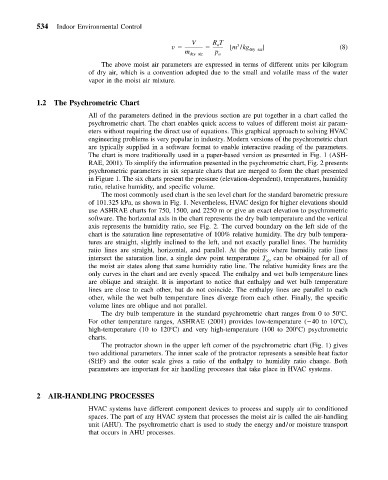Page 545 - Mechanical Engineers' Handbook (Volume 4)
P. 545
534 Indoor Environmental Control
V R T
v a [m /kg dry air ] (8)
3
m dry air p a
The above moist air parameters are expressed in terms of different units per kilogram
of dry air, which is a convention adopted due to the small and volatile mass of the water
vapor in the moist air mixture.
1.2 The Psychrometric Chart
All of the parameters defined in the previous section are put together in a chart called the
psychrometric chart. The chart enables quick access to values of different moist air param-
eters without requiring the direct use of equations. This graphical approach to solving HVAC
engineering problems is very popular in industry. Modern versions of the psychrometric chart
are typically supplied in a software format to enable interactive reading of the parameters.
The chart is more traditionally used in a paper-based version as presented in Fig. 1 (ASH-
RAE, 2001). To simplify the information presented in the psychrometric chart, Fig. 2 presents
psychrometric parameters in six separate charts that are merged to form the chart presented
in Figure 1. The six charts present the pressure (elevation-dependent), temperatures, humidity
ratio, relative humidity, and specific volume.
The most commonly used chart is the sea level chart for the standard barometric pressure
of 101.325 kPa, as shown in Fig. 1. Nevertheless, HVAC design for higher elevations should
use ASHRAE charts for 750, 1500, and 2250 m or give an exact elevation to psychrometric
software. The horizontal axis in the chart represents the dry bulb temperature and the vertical
axis represents the humidity ratio, see Fig. 2. The curved boundary on the left side of the
chart is the saturation line representative of 100% relative humidity. The dry bulb tempera-
tures are straight, slightly inclined to the left, and not exactly parallel lines. The humidity
ratio lines are straight, horizontal, and parallel. At the points where humidity ratio lines
intersect the saturation line, a single dew point temperature T dp can be obtained for all of
the moist air states along that same humidity ratio line. The relative humidity lines are the
only curves in the chart and are evenly spaced. The enthalpy and wet bulb temperature lines
are oblique and straight. It is important to notice that enthalpy and wet bulb temperature
lines are close to each other, but do not coincide. The enthalpy lines are parallel to each
other, while the wet bulb temperature lines diverge from each other. Finally, the specific
volume lines are oblique and not parallel.
The dry bulb temperature in the standard psychrometric chart ranges from 0 to 50 C.
For other temperature ranges, ASHRAE (2001) provides low-temperature ( 40 to 10 C),
high-temperature (10 to 120 C) and very high-temperature (100 to 200 C) psychrometric
charts.
The protractor shown in the upper left corner of the psychrometric chart (Fig. 1) gives
two additional parameters. The inner scale of the protractor represents a sensible heat factor
(SHF) and the outer scale gives a ratio of the enthalpy to humidity ratio change. Both
parameters are important for air handling processes that take place in HVAC systems.
2 AIR-HANDLING PROCESSES
HVAC systems have different component devices to process and supply air to conditioned
spaces. The part of any HVAC system that processes the moist air is called the air-handling
unit (AHU). The psychrometric chart is used to study the energy and/or moisture transport
that occurs in AHU processes.

